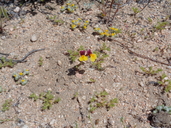Taxon Report
Erythranthe shevockii (Heckard & Bacig.) N.S. FragaKelso Creek monkeyflower |
 © 2021 Ryan O'Dell |
Taxon Summary
Erythranthe shevockii, commonly known as Kelso Creek monkeyflower, is a annual herb in the Phrymaceae that is found only in California. It occurs within Joshua tree "woodland", and Pinyon and juniper woodland, growing at elevations from 800 to 1340 meters. Erythranthe shevockii is ranked 1B.1, Plants Rare, Threatened or Endangered in California and Elsewhere; Seriously threatened in California.Classification
|
Scientific Name: |
Erythranthe shevockii (Heckard & Bacig.) N.S. Fraga |
|
Common Name: |
Kelso Creek monkeyflower |
| Family: | Phrymaceae |
| Element Code: | PDSCR1B2Z0 |
| USDA Plants Symbol: | |
|
Synonyms/Other Names: |
|
Ecology and Life History
| Lifeform: | annual herb |
| Blooming Period: Mar-May | Mar-May |
| Elevation: | 800-1340 (2625-4395) |
| General Habitats: | Joshua tree "woodland", Pinyon and juniper woodland |
| Microhabitat: | Granitic (sometimes), Gravelly (sometimes), Metamorphic (sometimes), Sandy (sometimes) |
| Microhabitat Details: |
Conservation Status
| CA Rare Plant Rank: | 1B.1 |
| Global Rank: | G1 |
|
State Rank: |
S1 |
| State List: | None |
| Fed List: | None |
| Other Status: | BLM_S; SB_CalBG/RSABG; USFS_S |
|
CRPR Changes: |
|
Occurrence Data from the CNDDB
| Total Occurrences: | 13 |
| Element Occurrence Ranks: | |
| Excellent (A) | 1 |
| Good (B) | 10 |
| Fair (C) | 1 |
| Poor (D) | 0 |
| None (X) | 0 |
| Unknown (U) | 1 |
| California Endemic: True | |
| California Counties and Islands: Name (Code) | |
| Kern (KRN) | |
| Quads: Name (Quad Code) | |
| Cane Canyon (3511852), Claraville (3511843), Lake Isabella North (3511864), Pinyon Mtn. (3511842), Weldon (3511863), Woolstalf Creek (3511853) | |
Threat List Data from the CNDDB
| Threat List Total: | 9 | |
| EOs with Threat Listed: | Total EOs | % of EOs |
| 10 | 77 % | |
| ORV activity | 9 | 69% |
| Grazing | 7 | 53% |
| Development | 6 | 46% |
| Road/trail construction/maint. | 4 | 30% |
| Recreational use (non-ORV) | 2 | 15% |
| Erosion/runoff | 2 | 15% |
| Non-native plant impacts | 1 | 7% |
| Wood cutting or brush clearing | 1 | 7% |
| Agriculture | 1 | 7% |
Citation
California Native Plant Society, Rare Plant Program. 2025. Rare Plant Inventory (online edition, v9.5.1). Website https://www.rareplants.cnps.org [accessed 15 December 2025].